Next Tuesday, 25th October, at 8pm, Kieran McCarthy will give a lecture to Blackpool Historical Society at 8pm in Blackpool Community Centre behind Blackpool church; the title of the talk is “Creating an Irish Free State City: Cork in the 1920s and 1930s”; if you ever wondered how places like Turners Cross and Gurranabraher came into being and want to see Cork in the early twentieth century, this talk will attempt to cover some of those aspects.
Group photo, recent historical walking tour of St Finbarr’s Hospital, October 2011
Thanks to everyone who recently went on the historical walking tour of St. Finbarr’s Hospital.
It was great to get a lunchtime tour off the ground. Thanks to the staff of the hospital for suggesting it! With the weather, it will probably be next year before the next tour of some aspect of the ward. But planning to convert the Douglas lecture given during heritage week into a walking tour and build one around the Blackrock pier area.
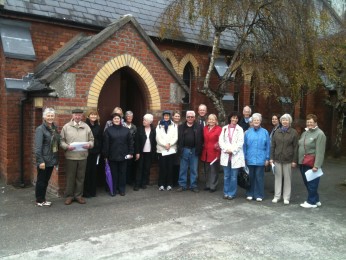
Kieran’s Our City, Our Town, 20 October 2011
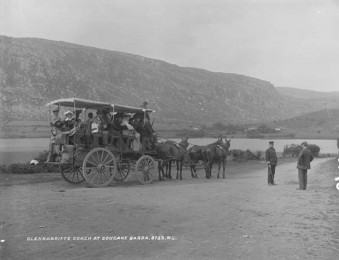
Kieran’s Our City, Our Town Article,
Cork Independent, 20 October 2011
In the Footsteps of St. Finbarre (Part 271)
Routeways in Culture
Continuing on from last week’s column, Fr. Patrick Hurley’s obituary following his death on 25 June 1908 in the Cork Examiner acknowledges him as a staunch advocate of the Irish language movement. He held the Presidency of the first Munster Irish Training College in Ballingeary since its inception in 1903. The college opened for two sessions, July and August in 1904. Mr. Dermot Foley was in charge, assisted by Rev. O’Daly and Mr. Tadgh Scannell.
Lessons were given in the method of teaching Irish phonetics and metrics of Irish poetry. Special classes in text books for national teachers were given as well as conversational lessons, and lectures in Irish history. The language of the school was as much as possible in Irish. Over seventy students attended each session as well as several priests from all parts of Ireland, professors in colleges, national teachers and Gaelic League organisers. The Archbishop of Cashel as well as the Bishop of Cork and the other Bishops of Munster, became patrons of the college. They helped it through donations. Fr. Hurley’s long term plan was that perhaps the college would eventually be housed on the ancient site near Gougane Barra. This did not materialise but the project did start off in the dining area of Cronin’s Hotel.
According to a Southern Star, Ballingeary Notes column on 1 November 1930 Tadhg Scannell hailed from Coolea and until his arrival in Ballingeary, not one pupil it is noted in any national school in the village, or in the parish had been presented for examination in Irish at the Annual Results Examination in the National Schools. Through Tadgh’s interventions he won the national O’Brien Cup for having secured the highest number of passes in all Ireland, three years in succession. He also helped the Christian Brothers to prepare their compiled school text books of the Irish language and he often placed his knowledge of the subject at the disposal of advanced literary students.
Fr. Hurley also promoted an industrial revival amongst local people. His obituary in the Cork Examiner of 1908 further notes that he highlighted scientific agricultural methods, which he passed on to the farmers of the district. He also brought lecturers into the area to share their ideas of cultivation in difficult landscapes for growing crops and dairy farming.
In addition Fr. Hurley pushed for a lace-making industry in the district. He opened up the Gaeltacht countryside by inducing the Tourist Development Company to run coaches to Glengariff and Killarney, via Macroom and Gougane Barra. He successfully lobbied local MPs for the improvement of the roads to bring in more tourism into the region. From that he approached Cork railway companies to create grand tour programmes in West Cork, which created tours to Bantry, Glengarriff with Gougane Barra bring part of a wider itinerary.
An article in the Southern Star on 15 June 1907 (p.5) echoes Fr Hurley’s work and outlines: “The establishment of a motor service along the tourist route from Macroom to Killarney, via Inchigeela, Gougane Barra, Keimaneigh, Glengarriff etc constitutes a decided step towards the development of tourist traffic in the south…the coaches have been doing very on this route for the past number of years, but the motor car possessed advantages that are altogether lacking on the old system. The scenery loses some of its attractiveness, when viewed from the motor-car, and the speed at which the uninteresting parts of the route are covered will offer an opportunity for a pause where the passengers show a desire to contemplate the scenic beauties that present themselves at intervals. In cold and inclement weather too, the motor car will have far greater attraction for the tourist than the open coach that occupies the whole day on the road. In fine weather also new and unbeaten tracks may be opened up by the motor.”
At this time also, the Cork and Macroom Direct Railway Company (1861-1953) also advertised its tourist route to Glengarriff and Killarney via a number of sites (several of which have been written about in Our City, Our Town over the Lee series). An advertisement in the Freeman’s Journal in July 1914 notes that: “Tourists by this route have an opportunity of going through the most scenery in Ireland. Proceeding from Cork to Macroom by Train, the following interesting Ruins, etc., can be seen from the railway carriage, Ballincollig or Barrett’s Castle, Kilcrea Abbey, Crookstown Castle or Castlemore, Mashanaglass Castle, the meeting of the waters at Coolcower Bridge, Lee and Sullane, the meeting of the waters at Macroom Bridge- the Sullane and Laney. On arrival at Macroom by Train, tourists proceed by well-appointed Motor Coaches to Killarney via Glengarriff. The road runs for Four Miles along the fringe of the Celebrated Lakes of Inchigeela, and thence to the far-famed Holy Lake of Lone Gougane Barra, at the source of the Lee, on an island of which is situated the hermitage of St. Finbarre, with the ruins of the Chapel and Cloister. Thence through the magnificent Pass of Keimaneigh (the Khyber of Ireland), admitted to be the finest in the Kingdom. Shortly after leaving the Pass the first grand view is obtained of Bantry Bay.”
To be continued…
Captions:
613a. Coach at Gougane Barra, c.1910 (William Lawrence Photographic Collection)
613b. Photo call on the closing days of Cork and Macroom Direct Railway, 1953 (picture: ESB Archives, Dublin)
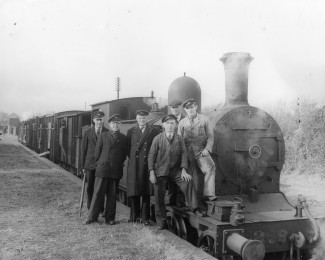
New Plans on Display, Blackrock Harbour Redevelopment, October 2011
Cork City Council aims to redevelop the Blackrock Harbour Area. The project consists of a large public open space, a park on the grounds of the former Ursuline Convent, a boardwalk linking Blackrock Harbour with Blackrock Castle, the widening of Convent Road and other related measures.
Particulars of the proposal will be available for inspection at the Reception Desk, Cork City Council, City Hall, Cork, from 17th October 2011 until 2nd December 2011 between the hours of 9:00am to 4.00pm Monday to Friday.
Submissions and observations, dealing with the proper planning and development of the area in which the proposed development is situated, may be made in writing in an envelope clearly marked “Blackrock Harbour Redevelopment” to the Roads Design Division, Room 331, City Hall, Cork before 16th December 2011.
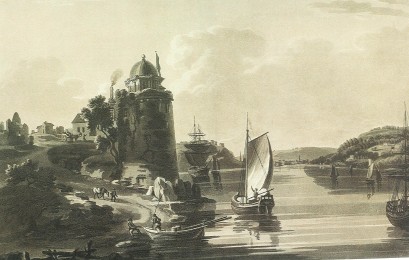
Kieran’s Our City, Our Town, 13 October 2011
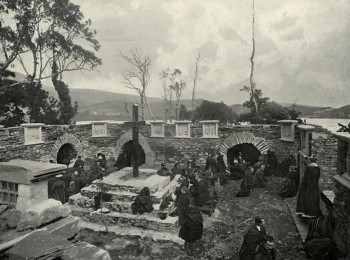
Kieran’s Our City, Our Town Article,
Cork Independent, 15 October 2011
In the Footsteps of St. Finbarre (Part 270)
The Reworking of Memories
On my perch next to the main set of cells in Gougane Barra, many come looking for the old money tree. For many years, the remains of an old cross stood alongside the tree. This may have the cross that Fr Patrick Hurley, the Parish Priest commissioned in the early 1900s. The cross, which was made of yew from Ardmore, was erected by Mr. Buckley of Youghal and had on it in three languages – English, Latin and Irish, on an enamelled plate, the following inscription, “Here stood in the sixth century the cell of St Finbar, first Bishop of Cork”. This cross for many years in the twentieth century also had coins stuck in it and was replaced in recent years by the present cross.
Fr Hurley in the first decade of the 1900s also pursued some work on Father Denis O’Mahony’s tomb, which he notes in 1892 in his article in the Journal of the Cork Historical and Archaeological Society, as very much neglected. On taking off the old flagstone covering it, he discovered an inscription on it (and was nearly obliterated) of a beautifully-carved limestone cross, from a model of one in St Mary’s Church, Youghal, County Cork. He got the stone inscribed with a cross, chalice and host. Portions of the coffin, made of black oak, in the tomb were opened. The bones were carefully collected and placed in an oak case with a suitable inscription.
On the pilgrimage island Fr Hurley commissioned a memorial in memory of J.J. Callanan, poet, author of the poem Gougane Barra, and noting on the inscription “Born in Cork AD 1795. Died in Lisbon, where he is buried, the 15th September 1829 – RIP”. Jeremiah Joseph Callanan (1795–1829) was an Irish poet born in County Cork, Ireland. Callanan studied for Catholic priesthood at Maynooth College, and afterwards law at Trinity College, Dublin, where he won two prizes for his poems. Afterwards, he found employment teaching briefly at a school in his hometown of Cork. Callanan also contributed translations of Irish verse to Blackwood’s Magazine, which was run by another promoter of Irish literature, Dr William Maginn. For four years up to 1827 Callanan spent much of his time going around Cork and the south west of Munster collecting old ballads and legends and having them translated and published. One of his most famous translations was that of an Irish poem on Gougane Barra (translated to Gougane Barra). In 1827 he travelled to Lisbon to work as a tutor in 1827. He died in Lisbon in 1829 as he was preparing to return to Ireland.
In an article in the Irish Independent in 1905, Fr Hurley reveals his strategy for social improvement amongst the people of the surrounding region. He noted that on his arrival he found the Irish language on the point of going. He discouraged this, and in the schools, and from the altar he impressed on the local people “the beauty of their own language [Irish]”. Fr Hurley’s work was part of a larger revival in Gaelic culture in Ireland at that time. In 1893 Douglas Hyde played the leading role in the foundation of the Gaelic League. The purpose of the league was to revive the disappearing culture and traditions, and its work stimulated considerable popular enthusiasm for the study of the Irish language. In particular the Catholic Church played a large role in attending League meetings and promoting the Irish language. This is apparent in the myriad of articles, which record their contribution in the Cork context at least in the Cork Examiner from the early years of the 1900s.
In addition in an attempt to encourage the use of the Irish language in schools, Fr Hurley made the acquaintance of Rev Richard O’Daly, a priest of a diocese of Goulbourne, Australia, who made his studies at the College of Propaganda, Rome. He had an opportunity there of studying languages from his contacts with students from all nations, and subsequently travelled through Europe, where he acquired a knowledge of nearly every European language. Born in Australia, but with parents from the Ballingeary area, he wished to learn the Irish language. He began learning at the Gaelic League classes in London, where for a short time he did missionary work. Coming to Ballingeary, he perfected his knowledge of Irish, and Fr Hurley secured his services to serve the pilgrims coming to pray at Gougane Barra.
In the summer of 1903 Fr Daly invited Irish scholars to Ballingeary from several parts of Ireland. This was the start of the Irish college in the region. In the autumn of 1903, at a “Feis” at Ballingeary, a village four miles from Gougane Barra, Father Goulding, of New Zealand, offered an annual subscription towards an Irish College at Gougane Barra. The London Gaelic League and the Dublin branches also subscribed. It was found the accommodation at Gougane Barra was too limited, and it was arranged to have the Irish college opened in Ballingeary, where there was a good hall for lectures, excellent schools where the children were Irish-speaking, and places where lodgings could be had in the immediate area.
To be continued…
Captions:
612a. Pilgrims, Gougane Barra, Co. Cork, c.1900 (pictures: Ebay postcards)
612b. Pilgrims, Gougane Barra, Co. Cork, c.1920 (growth has returned to the previously cleaned walls of the cell complex).
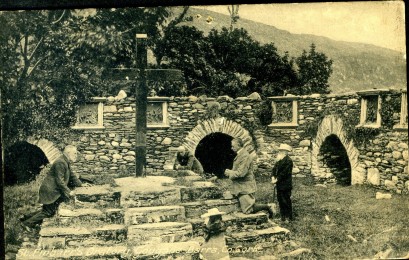
Kieran’s Question and Motions to the City Manager, Cork City Council Meeting, 10 October 2011
Question to the City Manager:
To ask the City Manager, when will the lamps on St. Patrick’s Bridge and Parliament Bridge be repaired? (Cllr Kieran McCarthy)
Motions:
That the council replace the rusted bin outside the Lions Den Bar on Douglas Road (Cllr K McCarthy)
That the Council consider installing resident’s disc parking at Bellair estate, where the estate fronts onto Douglas Road by the bus stop (Cllr K McCarthy)
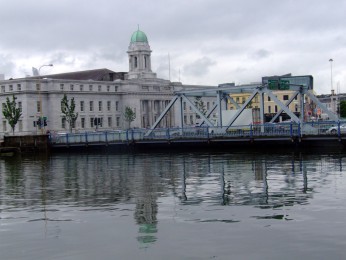
Kieran’s Our City, Our Town, 7 October 2011
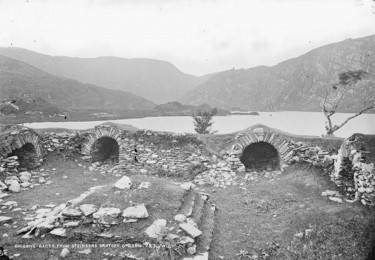
611a. Central pilgrimage cells, Gougane Barra, Co. Cork, c.1890 (source: National Library, Dublin)
Kieran’s Article, Our City, Our Town,
Cork Independent, 6 October 2011
In the Footsteps of St. Finbarre (Part 269)
A Sanctuary of Knowledge
Sitting on a ruin chatting to those who come to view the new exhibition, people come with many ideas and questions about Gougane Barra, about its evolution plus its spirit of place. Certainly to the people I chatted to, all had various perspectives on the site and its meanings to them, all of which would create interesting columns in themselves. Gougane Barra as a place has many layers of memories, indeed so has the River Lee valley.
Perhaps for me, one of the people who epitomises for me the spirit of the memories in the valley is Fr Patrick Hurley, who was sent by the Bishop of the Diocese of Cork and Ross into Gougane Barra in 1888. Perhaps it is his interests in history and archaeology that grab me. To have interests enough to promote the creation of the new oratory in 1901 is noteworthy (see last week), but perhaps it is his ambition and energy to actually do something for the people in his parish, which is also impressive. Certainly those threads such as developing the merits and energies of a place appear in other places, which have been written about in this column within the valley. Born in 1841 in Enniskeane, near Bandon, Co. Cork, Fr Hurley certainly would have had experienced the ravages of the Famine in rural Ireland. He received his early education in the then Diocesan Seminary in Cork and completed his course in the Irish College in Paris. He was ordained in 1865 at the age of 24.
After ordination, Fr Hurley was appointed to Schull, Co. Cork for a short time but was transferred in 1867 to Kilbrittain, Co. Cork and in 1869 he was appointed to Blackrock, Co. Cork. After spending six years in Blackrock, Fr Hurley was transferred to SS Mary and Anne’s North Cathedral, Cork City and was elected as chaplain to Bishop William Delaney. Fr Hurley experienced the slums of Cork’s northside and sought to improve the lack of education facilities in the area and set about establishing a school at the Confraternity Hall attached to the North Cathedral, Cork City.
In 1872 the Bishop of Cork Dr Delaney, wished to raise the profile of the pilgrimage island in Gougane Barra. He paid a visit to the Carthusian monks in the Chartreuse Mountains, to the north of the city of Grenoble in France. His visit aimed to get some of the monks to settle in Gougane Barra. Four of the Carthusian monks came the next year to see Gougane Barra but abandoned the idea. However, their advent had one result – the leasing of the island on 29 January 1873 at a nominal rent of one shilling from Mr Townsend, Uncle of a Captain Townsend, the proprietor, to the Dr Delany and Parish Priest of Inchigeela, Fr Jeremiah Holland.
Two years after the death of Bishop Delany, Fr Hurley was involved in securing Gougane Barra for the Diocese of Cork in 1888 (Hurley, 1905). Subsequently he was sent to Gougane Barra by the new Bishop O’Callaghan, Dr O’Callaghan to administer in that area of West Cork. This appointment was made in May 1888 on the death of Fr Holland.
Fr Patrick Hurley’s obituary in The Cork Examiner, on 26 June 1908, and in the Journal of the Royal Society of Antiquities of Ireland for 1909 reveals a learned man. During his late forties, Fr. Hurley developed an interest in the history of the Diocese of Cork and Ross. He published a number of articles in the Irish Ecclesiastical Record (1887) concerning Cork Bishops and their lives, namely Dr Robert Barry, Bishop of Cork and Cloyne, 1647-1662 and Dr Patrick Comerford, Bishop of Waterford and Lismore, 1629-1652.
Fr Hurley’s continued interest in antiquities is reflected in the fact he became a member of the Royal Society of Antiquities of Ireland in 1890 and in time became honorary local secretary for County Cork. The Royal Society of Antiquaries of Ireland was and still is a learned society based in Ireland, whose aims are “to preserve, examine and illustrate all ancient monuments and memorials of the arts, manners and customs of the past, as connected with the antiquities, language, literature and history of Ireland”.
Fr. Hurley was also a committee member and a contributor of articles to the Cork Historical and Archaeological Society (three articles in 1892 and one in 1896), which was founded in 1891 for the collection, preservation and diffusion of all available information regarding the City and County of Cork. One of his contributions in the 1892 journal explores the history of St Finbarre and folk-life in the nineteenth century re-visiting the work of antiquarian visitors to the site. Fr Hurley’s comments that the trees had become decayed and the walls of the pilgrimage enclosure, where tradition had it that St Finbarr had his cell were in a very dilapidated state. Fr. Hurley had the walls repaired, new Stations of the Cross in terracotta erected, and also the cross restored where it formerly stood.
Kieran’s new historical exhibition called Voices of the Lee Valley is on display next Saturday and Sunday afternoons on the pilgrimage island, Gougane Barra; all are welcome (last weekend).
To be continued…
Captions:
611a. Central pilgrimage cells, Gougane Barra, Co. Cork, c.1890 (source: National Library, Dublin)
611b. R Barry’s plan of Gougane Barra pilgrimage island, 1813 (source: Fr P. Hurley, 1892)
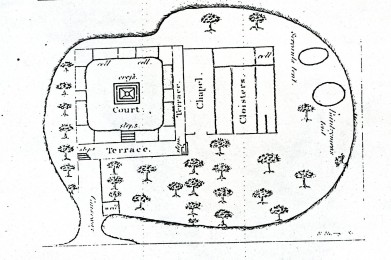
611b. R Barry’s plan of Gougane Barra pilgrimage island, 1813 (source: Fr P. Hurley, 1892)
Historical Walking Tour of St. Finbarre’s Hospital, Lunchtime, Monday 10 October 2011
On next Monday, 10 October, 12.30pm , Cllr Kieran McCarthy, in association with the staff of St Finbarr’s Hospital, will give a public historical walking tour of the hospital grounds (meet at gate). The walk is free and all are welcome. It is about an hour in duration. When the Irish Poor Relief Act was passed on 31 July 1838, the assistant Poor Law commissioner, William J. Voules came to Cork in September 1838 to implement the new laws. Meetings were held in towns throughout the country. By 1845, 123 workhouses had been built, formed into a series of districts or Poor Law Unions, each Poor Law Union containing at least one workhouse. The cost of poor relief was met by the payment of rates by owners of land and property in that district.
In 1841 eight acres, 1 rood and 23 perches were leased to the Poor Law Guardians from Daniel B. Foley, Evergreen House, Cork. Mr. Foley retained an acre, on which was Evergreen House with its surrounding gardens, which fronted South Douglas Road. The subsequent workhouse that was built on the leased lands was opened in December 1841. It was an isolated place, built beyond the City’s toll house and toll gates. The Douglas Road workhouse was also one of the first of over 130 workhouses to be designed by the Poor Law Commissioners’ architect George Wilkinson.
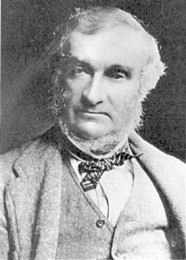
Kieran’s Our City, Our Town, 29 September 2011
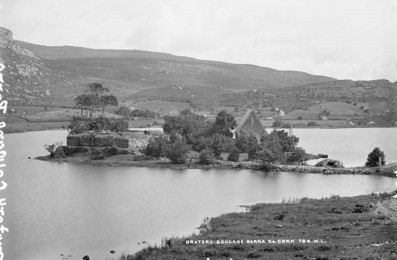
610a. Gougane Barra pilgrimage island before the 1901 oratory was built, note the old oratory (source: William Lawrence Photographic Collection)
Kieran’s Our City, Our Town Article,
Cork Independent, 29 September 2011
In the Footsteps of St. Finbarre (Part 268) – A Living Heritage
Sitting by my historical exhibition in Gougane Barra, I snap away the changing light and textures of Gougane Barra island. I love photographing the oratory in Gougane Barra. The sculptured head of St Finbarre for me is s a symbol of the entrance to the darkness of the interior beyond. On entering the oratory, I am always conscious on the movement from the mountainous setting to the interior of a church. I am always impressed by the silence inside this sheltered structure. The lit candles offer the only light. The stained glass windows with Irish saints reach out to me to tell the story of the early days of Christianity.
Characteristics of the oratory’s sacredness seems to be bound up with elements such as its visual presence even dominance on the pilgrimage island; the design of the architecture and overall meaning symbolism and thirdly the interior symbolism the pilgrim is led through. The Cork Examiner published the sermon of Fr Verdon who spoke at the official opening of the oratory on the Feast of the Assumption on the 15 August 1901 (p.6). He noted of the new oratory that it was “a temple raised to the Living God…it symbolised and imaged forth the material image of the Holy Catholic Church, that magnificent edifice, splendid, spiritual divine, founded by Christ upon the Rock”.
Rev C,M. O’Brien’s book on the Life of St Finbarr, possibly published to coincide with the dedication of the oratory, seems to serve as some kind of official guidebook to the oratory. He notes that St Finbarre’s Oratory (built c.1900/01) owes its origin to the local parish priest Fr Patrick Hurley who financed the erection of it to two wealthy Irish Americans in America (one living in Chicago). The new oratory replaced Fr Denis O’Mahony’s near two hundred year old ruinous oratory. Indeed, the entrance gable of the earlier oratory was still standing c.1900 as evidenced through photographs of the pilgrimage island by William Lawrence. The orientation of the oratory was changed from north to south in the older one to west to east in the newer one. The older gable wall was also taken down as revealed in early twentieth century photographs. Part of its stone maybe part of further ruins near the present oratory.
The design of the church is bound with the Gaelic revival of the late nineteenth century. That was a time when there was a resurgence of interest in engaging with the Gaelic language and ancient Irish folklore, sports, songs, architecture, and arts were considered to be part of the pre-English conquest heritage of the native Irish people. The oratory is built in Hiberno-Byzantine style and modelled after the Chapel of Cormac on the Rock of Cashel (begun in 1127 AD). Caiseal constitutes the most famous architectural assemblage to survive from Medieval Ireland. The entire summit of the Rock has a very complex mix of ideas about structure, space and meaning. The place is bound up with a sacred history – the legend of St Patrick converting the Munster Gaelic kings of old.
Mr Samuel F. Hynes, Cork, designed St Finbarr’s Oratory and the artist was Mr M.J.C. Buckley, Cork and Bruges, Belgium. Samuel F Hynes was part of a wider group of late nineteenth century architects employed to create new symbolism for the Catholic Church which was growing in strength since the sanctioning of the Catholic Emancipation Act in 1829. Samuel F Hynes prior to St Finbarr’s Oratory had been involved in the re-building or design of several additions of several churches. The chapel of the Convent of Mercy in Bantry was designed by him in 1877 and was a later addition to the Romanesque Revival complex. In 1895, Hynes was involved in the altering of the interior of St Mary’s Church, Pope’s Quay, Cork City. In August 1897 The Irish Builder published a report on his design work in the rebuilding of the Catholic church at Castletownroche. The previous year, Hynes had designed the new Catholic church at Lisgriffin, Co. Cork and was also involved in the design of Farranferris College in Cork City.
As for Michael J C Buckley, he was of Irish birth. He seems to have been in business on his own until around 1881 when he became a partner of Cox and Son. After the firm was bought out in the 1890s, Buckley appears to have returned to Ireland and continued to work. The walling is of mountain stone and is relieved by dressings of limestone, while the roof, like the Chapel of Cormac, was originally of stone, necessitated by the heavy rains that prevail in mountain districts. Rev C.M. O’Brien’s book Life of St Finbarrr (c.1901) notes that the western end of Gougane Oratory is ornamented by a boldly excised doorway of limestone, with hook shafts and caps and vases, the arches being enriched with chevron ornament. At the head of the label mould is a boldly cut head of St Finbarre. The original plan was to have a round tower at the entrance to the oratory but it was never completed.
Kieran’s new historical exhibition called Voices of the Lee Valley is on display next Saturday and Sunday afternoons on the pilgrimage island, Gougane Barra; all are welcome.
To be continued…
Captions:
610a. Gougane Barra pilgrimage island before the 1901 oratory was built, note the old oratory (source: William Lawrence Photographic Collection)
610b. St Finbarr’s Oratory, c.1901 (source: Ebay)
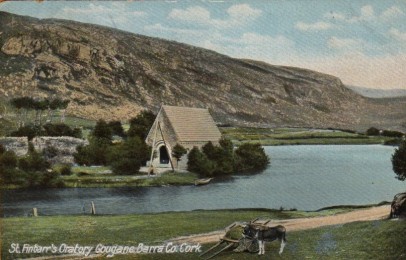
Kieran’s Response to the Savings of c.2m euros to be cut from Council Budget, Cork City Council Meeting, 26 September 2011
Lord Mayor, once again, we need to tighten the control rein on our finances – plus perhaps we need to critique what we have adapted in the Capital Works account such as the City Hall revamp. That we didn’t see these financial problems arise until now is short-sighted.
In addition, this report shows the poor state of the country’s finances. The drop in the collection of rates also shows that traders in the city are suffering, are as traders right across the country. The more we continue to do and we can do to stimulate trade the better for all. I would like to call on the government parties in the Council Chamber to relay the report back to the Cabinet.